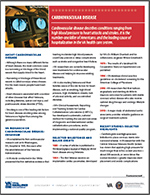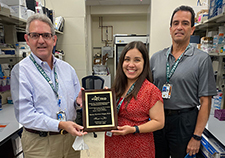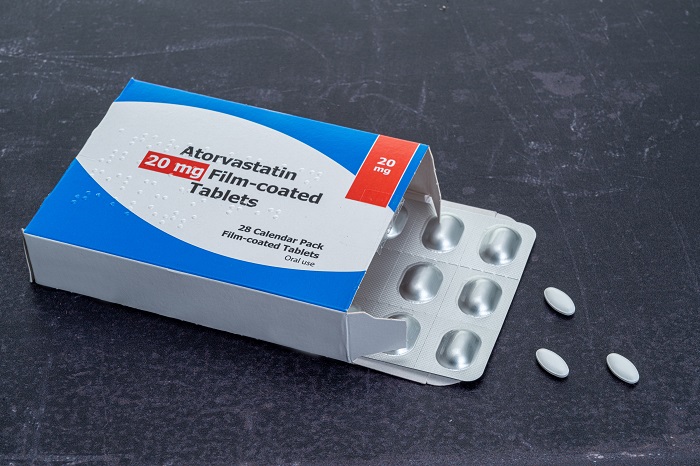Office of Research & Development |
 |
Cardiovascular disease refers to conditions that affect the heart or blood vessels. It describes conditions ranging from peripheral artery disease and high blood pressure to heart attacks and strokes. It is the number-one killer of Americans, and the leading cause of hospitalization in the VA health care system. It is also a major cause of disability.
Another reason why cardiovascular disease is particularly important to Veterans is that it is associated with a number of other diseases that often affect them. These include diabetes, spinal cord injuries, and posttraumatic stress disorder.
Although there are many different forms of cardiovascular disease, one of the most common forms is a narrowing or a blocking of the blood vessels that supply blood to the heart. This is called coronary artery disease (CAD), and is the main reason people have heart attacks.
A VA study conducted in the 1960s generated the first definitive evidence that treating moderate high blood pressure helps prevent and delay the complications hypertension can bring. These complications can include heart disease, kidney disease, stroke, and CAD. In the years since, VA has continued its leadership in the study of cardiovascular disease.
VA researchers are developing new treatments for cardiovascular disease and helping to improve existing treatments. They are looking at the genetic and lifestyle causes of the disease and are conducting studies ranging from lab experiments to large clinical trials involving thousands of patients.
VA is also making Veterans and their families aware of the risk factors for cardiovascular disease. Besides high blood pressure, these include smoking, high cholesterol, obesity, lack of physical activity, and uncontrolled diabetes. The department offers a number of evidence-based programs to help Veterans manage these conditions. VA researchers review these programs, evaluate their effectiveness, and make suggestions for improvements.
VA established its first cardiovascular research unit at its Washington, DC. hospital in 1935, five years after the Veterans Administration (the predecessor agency to the Department of Veterans Affairs) was established.
In 1948, the unit's researchers began a study of some of the many young service members who had had heart attacks during their World War II service. The researchers found that the Veterans' blood pressures at the time of their enlistment were higher, on average, than the control group--men who were later treated by VA for amputations.
By the 1950s, a number of drugs were available to treat high blood pressure. The cardiovascular unit led a study to determine how well the newer drugs actually worked. Then, under the direction of Dr. Edward Freis, VA investigators conducted a study to find out whether using these drugs to control blood pressure actually led to the prevention of heart attacks, strokes, and other complications of heart disease.
From January 1964 through October 1969, 17 VA hospitals and 523 patients with blood pressure above normal levels participated in the study. Half of the patients received the best available regimen for treating moderate high blood pressure, and the other half received a placebo. The trial was quickly stopped for patients with significantly high diastolic blood pressure (above 115 mm/l), because the number of strokes and heart attacks in that group was so high that they simply had to be given medicine, and quickly.
In 1969, a senior VA medical official, Dr. Thomas Chalmers, looked at the results for Veterans remaining in the study, and decided the data indicated that everyone receiving placebos needed to be started on medicine, thereby ending the trial.
The results were written up in the Journal of the American Medical Association in August 1970, and presented the first definite and convincing evidence that treating moderate high blood pressure was beneficial in preventing or delaying many of its catastrophic health complications.
On a separate track, during the 1950s Dr. William Chardack, Dr. Andrew A. Gage, and engineer Wilson Greatbatch created an electronic device to regulate the human heart. Their device, called a pacemaker, was first successfully implanted in the Buffalo VA hospital on April 7, 1960, in a 77-year-old man. The man lived for 33 months after the implantation.
The device was patented, and an agreement to license production of the device to Medtronic in 1961 "effectively began the modern medical device industry," according to Seymour Furman, M.D., a cardiologist who wrote the forward to the book The Making of the Pacemaker, which was written by Greatbatch in 2000.
High blood pressure is a leading cause of death and disability in the United States and around the world. According to the National Institute of Aging, more than 60 percent of people over age 65 have high blood pressure, and the number of people with high blood pressure is increasing.
The Systolic Blood Pressure Intervention Trial (SPRINT) is a research study, funded by the National Institutes of Health and led in part by Dr. William C. Cushman of the Memphis VA Medical Center, to determine whether lower blood pressure will reduce the rate of heart and kidney diseases, stroke, or age-related declines in memory and thinking.
SPRINT randomly assigned 9361 men and women ages 50 or older at high risk of cardiovascular disease, or who already had kidney disease to one of two systolic blood pressure targets; less than 120 millimeters of mercury, or less than 140.
The research team ended the study a year early, in 2015, because it believed it had already conclusively answered the question the research posed. The team found that patients who were assigned to reach a systolic blood pressure goal below 120, which is far lower than current guidelines of 140 (or 150 for people over 60) had their risks of heart attacks, heart failure, and strokes reduced by a third, and their risk of death reduced by a quarter.
The results were published in the New England Journal of Medicine in 2015.
In 2007, a U.S. and Canadian research team published results from a study of patients who experienced chest pain during physical exertion as a result of blocked arteries. The study, led by VA researchers, was called the COURAGE (Clinical Outcomes Utilizing Revascularization and Aggressive Drug Evaluation) trial.
The team found that relieving artery blockage by percutaneous coronary intervention (PCI), which involves the use of balloon angioplasty plus stenting, did little to improve outcomes for 2,287 patients with stable coronary artery disease who also received optimal drug therapy and underwent lifestyle changes. (Coronary artery disease is defined as the impedance or blocking of one or more arteries that supply blood to the heart, usually due to hardening of the arteries.)
The original study involved patients at 15 VA medical centers and 35 non-VA hospitals in the United States and Canada. Most participants were males, with an average age of 62. All had at least one coronary artery that was more than 70 percent blocked and experienced regular chest pain, or angina, at least several times per week.
In 2015, the COURAGE team published long-term survival data on a subset of patients from the original study, and found that the team's initial conclusions were correct: there was no advantage to PCI over optimal medical therapy in terms of staying alive, which was the only outcome the team tracked.
The follow-up study, like the original trial, was published in the New England Journal of Medicine.
A 2016 study in which most of the investigators were not associated with VA (although two were) found that older men treated within the VA health care system for acute myocardial infarctions (heart attacks) are less likely to die within 30 days after the event than Medicare beneficiaries treated at other hospitals, although they are more likely to require readmission during the same time period. The team found, however, that mortality rates and readmission rates were higher at VA hospitals was higher for pneumonia.
The researchers studied 104 VA and 1513 non-VA hospitals, and compared mortality and readmission rates among Veterans and male Medicare fee-for-service beneficiaries. The data came from VA and the Centers for Medicare and Medicaid Services.
The team hypothesized that the lower rates of mortality for cardiovascular conditions seen in VA hospitals could be a reflection of higher quality of care indicated by better adherence to process measures, and could also be related to quality improvement efforts that have been implemented across the system.
The study was published in the Journal of the American Medical Association. In an accompanying editorial, a researcher associated with the Harvard T.H. Chan School of Public Health wrote that "these findings are important because they suggest that despite all of the challenges VA hospitals have faced, they are still able to deliver high-quality care for some of the sickest, most complicated patients."
Trauma exposure—A number of VA studies have found that exposure to trauma affects not only the mind, but also the body—especially the heart. One such study, published in 2013,
suggested that posttraumatic stress disorder (PTSD) might be a fast track to developing premature cardiovascular disease, and examined the changes in the body PTSD causes that might be responsible for this association. The study was done by researchers with VA and the University of California, San Diego.
Another 2013 study looked at 663 Veterans at two VA facilities, and found that Veterans with PTSD were more likely to have reduced blood flow to the heart, or ischemia. The condition was present in 17 percent of those with PTSD, and 10 percent of the non-PTSD group. After adjusting for factors known to influence heart disease, the researchers found that PTSD was associated with more than double the risk for ischemia—and the more severe the PTSD symptoms were, the greater the risk.
A 2015 study by researchers with the VA Pacific Islands Health Care System, the VA National Center for PTSD, and two universities looked at more than 8,000 Veterans living in Hawaii and the Pacific Islands, and found that those with PTSD had a nearly 50 percent greater risk of developing heart failure over about a seven-year follow-up period, compared with Veterans who did not have PTSD.
About 21 percent of the total study group had a diagnosis of PTSD. Of the 371 cases of heart failure that occurred during the study, 287 occurred among those with PTSD, whereas only 84 cases occurred among the group without PTSD. According to the study's authors, this was the first large-scale longitudinal study to report an association between PTSD and heart failure in an outpatient sample of U.S. Veterans.
Cardiovascular disease and combat deployment—In 2014, VA and Department of Defense (DoD) researchers found that not only were PTSD symptoms linked to heart disease, but so was combat deployment. The study found that while there was a link between PTSD and coronary heart disease (CHD), that link was largely explained by the presence of two conditions that often accompany the disorder: depression and anxiety. When the team adjusted for those two mental health conditions, the relationship was no longer significant.
However, combat deployment itself was linked to CHD. There were 627 newly reported cases of the disease among the study population of more than 60,000 service members and recent Veterans, and the odds of this diagnosis were 60 percent higher among combat deployers, versus noncombat deployers. The researchers hypothesized that experiencing intense stress may increase the risk for CHD over a relatively short period among young adults.
Cardiac catheterization—Cardiac catheterization is a procedure that's used to diagnose and treat cardiovascular conditions. During the procedure, a long thin tube called a catheter is inserted in an artery or vein in the groin, neck, or arm, and is threaded through the blood vessels to the heart. The procedure allows cardiologists to investigate what's going on in the heart, or to open blocked arteries impeding blood flow.
Through the CART-CL (Clinical Assessment Reporting and Tracking System for Cath Labs) program, VA researchers are focusing in on how this procedure is done at VA laboratories throughout the nation. The CART-CL program collects data from all 77 VA cath labs. Researchers use that data to improve VA's clinical performance.
A 2015 study by researchers with the VA Ann Arbor Healthcare system and the University of Michigan used data from this program to look at nearly 86,000 Veterans who underwent the procedure at a VA facility between October 2007 and September 2012. Nearly 3,200 of those Veterans were women.
The researchers found that women Veterans who underwent the procedure tended to be younger and more obese than men, and that they were more likely to have PTSD or depression. They were also significantly less likely to have obstructive coronary disease, and consequently were less likely to have been prescribed heart medications.
However, their long-term health outcomes were about the same as those of their male counterparts. According to the research team, the findings suggest that a significant percentage of women Veterans may have chest pain that is not attributable to obstructive coronary artery disease, and that further research is needed into the reasons for that chest pain.
For seven and a half years, researchers involved in a VA cooperative study (CSP 465) looked at nearly 1,800 patients with diabetes. The researchers examined cardiovascular disease, the cause of death in nearly two-thirds of patients with diabetes.
Researchers attempted to determine whether intensive glucose control (using medication and other methods to reduce the level of sugar in the blood in diabetic patients to levels that would be normal in patients without diabetes) reduced heart attacks, strokes, and death from cardiovascular disease.
It had been previously shown that improvements in blood pressure and cholesterol levels can reduce cardiovascular disease in patients with diabetes, but no previous study had shown the beneficial effects of glucose control on cardiovascular disease.
VADT researchers showed that intensive glucose control in patients whose type 2 diabetes had previously been poorly controlled had no significant effect on the rates of major cardiovascular events such as coronary artery disease and stroke, compared to those who were using standard glucose control measures.
The research team also found that the two groups of patients had similar death rates, and that both groups had similar levels of complications such as diabetic neuropathy and retinopathy, except that patients using standard glucose control measures had higher levels of albumin in their urine. (Albumin in the urine is a possible indicator of kidney disease.)
The trial researchers concluded that both very high and very low blood sugar levels can be dangerous, and that big swings between high and low levels are also potentially harmful.
As a follow up to VADT, VA researchers looked at whether the improvements in glucose control made by one of the groups in the trial were sustainable over the long term. They collected information on the VADT cohort for more than nine years of additional study, using VA's electronic records system.
The team reported in 2015 that patients who had been in the intensive-control group had a lower incidence of cardiovascular events after the trial was over, but their survival rates were no better than those of the other group.
According to study lead author Dr. Rodney Hayward of the Ann Arbor VA Healthcare System and the University of Michigan, "Taken together with findings from other large studies, we see that controlling blood sugar in diabetes can indeed decrease cardiovascular risk, though we continue to see no effect on risk of dying during the same period. This finding reinforces the importance of combining good blood sugar control with control of other cardiovascular risk factors for a combined effect."
Another follow-up study using VADT data was published in 2016. VADT researchers found that serious hypoglycemia (a condition characterized by abnormally low levels of glucose in the bloodstream) may be associated with the progression of atherosclerosis.
Atherosclerosis is a common form of arteriosclerosis in which fatty substances form a deposit of plaque on the inner lining of arterial walls. This can restrict blood flow, and the plaques can burst, triggering a blood clot. Atherosclerosis is the usual cause of heart attacks, strokes, and peripheral vascular disease.
Among 197 patients who took part in the VADT trial, serious hypoglycemia, which the researchers defined as having had at least one episode in which the patient either lost consciousness or required medical or other assistance, was nearly three times more common in the intensive-control arm, compared with the standard-treatment group. However, the atherosclerosis of patients who were in the standard-treatment group and had serious hypoglycemia progressed much more quickly than that of others in the trial, including those with serious hypoglycemia in the intensive-treatment group.
According to the research team, the findings should raise awareness of hypoglycemia as a risk factor for cardiovascular disease. They offered several possible reasons why atherosclerosis may have progressed more quickly in the standard-treatment group, relative to the intensive-treatment group, but they suggested those hypotheses should be used only to stimulate further research on the issue, and not to guide treatment
Effects of treatment on morbidity in hypertension. Results in patients with diastolic blood pressures averaging I. 115 through 129 mm. II. 90 through 114 mm Hg. (No authors listed). Studies demonstrate that treating moderate hypertension is beneficial in preventing or delaying many of its catastrophic health complications. JAMA 1967;202;1028-1034 and JAMA 1970 Aug 17;213(7);1143-52.
Collaborative overview of randomised trials of antiplatelet therapy--I: Prevention of death, myocardial infarction, and stroke by prolonged antiplatelet therapy in various categories of patients. (No authors listed.) In a study of 100,000 patients, antiplatelet therapy such as aspirin was found to be protective against heart attacks, strokes, and other diseases. BMJ. 1994 January 8;308(6921): 81-106.
Gemfibrozil for the secondary prevention of coronary heart disease in men with low levels of high-density lipoprotein cholesterol. Veterans Affairs High-Density Lipoprotein Cholesterol Intervention Trial Study Group. Rubins HB, Robins SJ, Collins D, Fye CL, Anderson JW, Elam MB, Faas FH, Linares E, Schaefer EJ, Schectman G, Wilt T, Wittes J. Findings suggest that the rate of coronary events is reduced by raising HDL cholesterol levels and lowering levels of triglycerides without lowering LDL cholesterol levels. N Engl J Med, 1999 Aug 5;241(6):410-8.
Optimal medical therapy with or without PCI for stable coronary disease. Boden WE, O'Rourke RA, Tao KK, Hartigan PM, Maron DJ, Kostuk WJ, Knudtson M, Dada M, Casperson P, Harris CL, Chaitman BR, Shaw L, Gosselin G, Nawaz S, Title LM, Gau G, Blaustein AS, Booth DC, Bates ER, Spertus JA, Berman DS, Mancini GB, Weintraub WS; COURAGE Trial Research Group. As an initial management strategy in patients with stable coronary artery disease, percutaneous coronary intervention did not reduce the risk of death, myocardial infarction, or other major cardiovascular events when added to optimal medical therapy. N Engl J Med, 2007 Apr 12;356(15):1503-16.
Objective evidence of myocardial ischemia in patients with posttraumatic stress disorder. Turner JH, Neylan TC, Schiller NB, Li Y, Cohen BE. Of 663 Veteran study participants, ischemia was present in 17 percent of patients with PTSD versus 10 percent of patients without the disorder. The association remained significant after adjustments for potential confounders. Biol Psychiatry, 2013 Dec 1; 74(11:851-6.
Impact of combat deployment and posttraumatic stress disorder on newly reported coronary heart disease among US active duty and reserve forces. Crum-Cianflone NF, Bagnell ME, Shaller E, Boyko EJ, Smith B, Maynard C, Ulmer CS, Vernalis M, Smith TC. Combat deployments are associated with new-onset coronary heart disease among young U.S. service members and Veterans. Circulation. 2014 May 6:129(18):1813-20.
Characteristics and outcomes of women veterans undergoing cardiac catheterization in the Veterans Affairs healthcare system; insights from the VA CART program. Davis MB, Maddox TM, Langner P, Plomondon ME, Rumsfeld JS, Durvernoy CS. Women veterans undergoing catheterization are younger, have more obesity, depression, and posttraumatic stress disorder, less obstructive coronary artery disease, and similar long-term outcomes, compared with men. Circ Cardiovasc Qual Outcomes. 2015 Mar;8(2 Suppl 1):S39-47.
Posttraumatic stress disorder and incident heart failure among a community-based sample of US Veterans. Roy SS, Foraker RE, Girton RA, Mansfield AJ. Prevention and treatment efforts for heart failure and its associated risk factors should be expanded among US Veterans with PTSD. Am J Public Health, 2015 Apr;105(4):757-83.
Follow-up of glycemic control and cardiovascular outcomes in type 2 diabetes. Hayward RA, Reaven PD, Wiitala WL, Bahn GD, Reda DJ, Ge L, McCarren M, Duckworth WC, Emanuele NV, VADT Investigators. After nearly 10 years of follow-up, patients with type 2 diabetes who had been randomly assigned to intensive glucose control for 5.6 years had 8.6 fewer major cardiovascular events per 1000 person years than those assigned to standard therapy, but no improvement was seen in the rate of overall survival. N Engl J Med. 2015 Jun 4; 372(23):2197-206.
Normalization of testosterone level is associated with reduced incidence of myocardial infarction and mortality in men. Sharma R, Oni OA, Gupta K, Chen G, Sharma M, Dawn B, Sharma R, Parashara D, Savin VJ, Ambrose JA, Barua RS. Normalization of total testosterone levels after testosterone replacement therapy was associated with a significant reduction in all-cause mortality, heart attacks, and stroke. Eur Heart J. 2015 Oct 21;36(40):2706-15.
Association of Testosterone Therapy With Mortality, Myocardial Infarction, and Stroke in Men With Low Testosterone Levels . Vigen R, O'Donnell C, Baron A, Grunwald G, Maddox T, Bradley S, Barqawi A, Woning G, Wierman M, Plomondon M, Rumsfeld J, Ho PM. Among a cohort of men in the VA health care system who underwent coronary angiography and had a low serum testosterone level, the use of testosterone therapy was associated with increased risk of adverse outcomes. JAMA, 2013;310(17):1829-1836.
Effect of PCI on long-term survival in patients with stable ischemic heart disease. Sedlis SP, Hartigan PM, Teo KK, Maron DJ, Spertus JA, Mancini GB, Kostuk W, Chaitman BR, Berman D, Lorin JD, Dada M, Weintraub WS, Boden WE; COURAGE Trial Investigators. During an extended-follow-up of up to 15 years, the research team did not find a difference in survival between an initial strategy of PCI plus medical therapy and medical therapy alone in patients with stable ischemic heart disease. N Engl J Med, 2015 Nov 12;373(20):1937-46.
A randomized trial of intensive versus standard blood-pressure control. SPRINT Research Group, Wright JT Jr, Williamson JD, Whelton PK, Snyder JK, Sink KM, Rocco MV, Reboussin DM, Rahman M, Oparil S, Lewis CE, Kimmel PL, Johnson KC, Goff DC Jr, Fine LJ, Cutler JA, Cushman WC, Cheung AK, Ambrosius WC. Among patients at high risk for cardiovascular events but without diabetes, targeting a systolic blood pressure of less than 120 mm Hg, as compared with less than 140 mm Hg, resulted in lower rates of fatal and nonfatal major cardiovascular events and death from any cause, although significantly higher rates of some adverse events were observed in the intensive-treatment group. N Engl J Med, 2015 Nov 26;373(22):2103-16.
Association of admission to Veterans Affairs hospitals vs non-Veterans Affairs hospitals with mortality and readmission rates among older men hospitalized with acute myocardial infarction, heart failure, or pneumonia. Nuti SV, Qin L, Rumsfeld JS, Ross JS, Masoudi FA, Normand ST, Murugiah K, Bernheim SM, Suter LG, Krumholz HM. Among older men with acute myocardial infarction (AMI), heart failure (HF), or pneumonia, hospitalization at VA hospitals, compared with hospitalization at non-VA hospitals, was associated with lower 30-day risk-standardized all-cause mortality rates for AMI and HF, and higher 30-day risk-standardized all-cause readmission rates for all 3 conditions, both nationally and within similar geographic areas, although absolute differences between these outcomes at VA and non-VA hospitals were small. JAMA 2016;315(6):582-592.
A link between hypoglycemia and progression of atherosclerosis in the Veterans Affairs Diabetes Trial (VADT). Saremi A, Bahn GD, Reaven PD, Veterans Affairs Diabetes Trial (VADT). Despite a higher frequency of serious hypoglycemia in the intensive therapy group, serious hypoglycemia was associated with progression of coronary artery calcification in only the standard therapy group. Diabetes Care. 2016 Jan 19. (Epub ahead of print.)

Download PDF
 VA Study Documents Health Risks for Burn Pit Exposures
VA Study Documents Health Risks for Burn Pit Exposures
 VA center training the next generation of researchers in blood clots and inflammation
VA center training the next generation of researchers in blood clots and inflammation
 Could cholesterol medicine reduce dementia risk in seniors?
Could cholesterol medicine reduce dementia risk in seniors?
 Million Veteran Program director speaks at international forum
Million Veteran Program director speaks at international forum
Could testosterone therapy help men live longer? The Washington Post, Aug.11, 2015
Researchers identify a new approach for lowering harmful lipids, SUNY Downstate Medical Center news release, Sept. 3, 2015
Data on benefits of lower blood pressure brings clarity for doctors and patients, The New York Times, Nov. 9, 2015
3 Things to know about the Sprint blood pressure trial, The New York Times, Nov. 9, 2015
The art of appropriate patient selection for heart procedures, Yale News, Nov. 9, 2015
3-D printed heart model for surgery highlights innovations, Orlando Sentinel, Jan. 18, 2016
Study compares outcomes at VA hospitals vs. non-VA hospitals, Medicalxpress, Feb. 9, 2016
Women Veterans with chest pain heavier, more depressed than men, University of Michigan news release, Feb. 11, 2016
Cardiovascular Disease - Quality of Care, U.S. Department of Veterans Affairs
Ischemic Heart Disease and Agent Orange, U.S. Department of Veterans Affairs
Chronic Heart Failure Quality Enhancement Research Initiative, U.S. Department of Veterans Affairs
Heart Disease, Centers for Disease Control and Prevention
Heart Diseases, Medline Plus, National Library of Medicine
Heart Disease and Stroke, healthypeople.gov
NINDS Stroke Information Page, National Institute of Neurological Disorders and Stroke